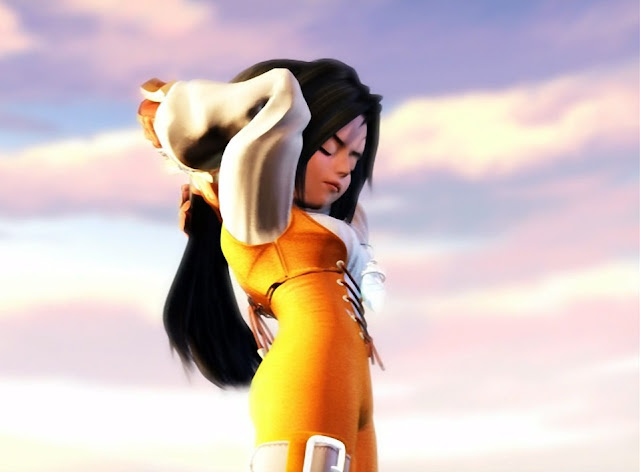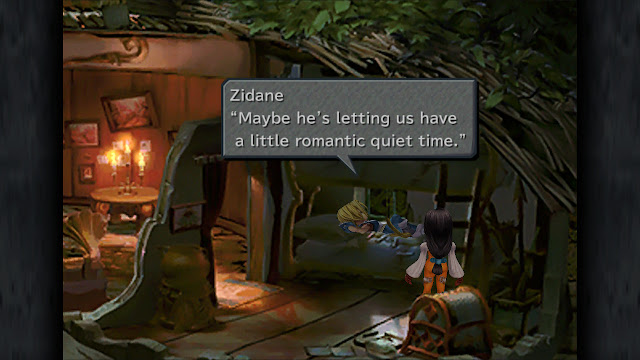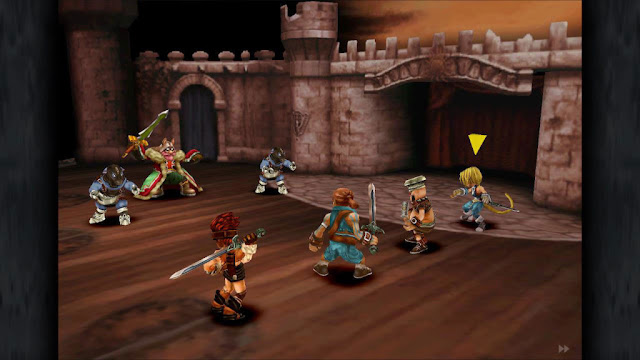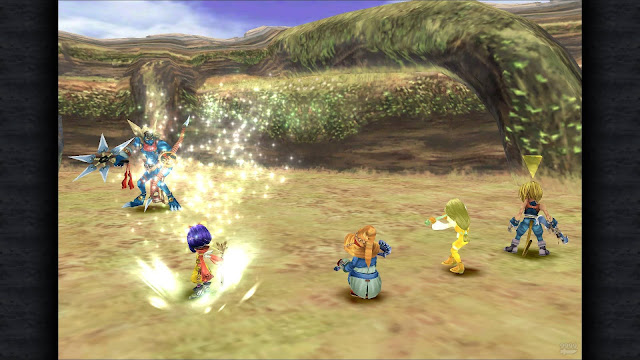Article by Priscilla M.
It’s not every day that you get an excuse to play and write about an eighteen-year-old game with fresh eyes – and yet I was lucky enough to do so with the Switch port of Final Fantasy IX. This is genuinely the first time I’ve played it. Final Fantasy IX, originally released in Europe by then-Squaresoft in 2001, follows Zidane Tribal, who belongs to a ragtag group of thieves known as Tantalus, who are tasked with the job of kidnapping the princess of Alexandria – Garnet Til Alexandros XVII. Along the way, they adventure with a range of interesting cast members: a ragtag bunch whom all have their own internal personal identity crises (a theme recurring throughout the game’s duration).
Related reading: Check out another retro look back at an old Final Fantasy game, in this case, Final Fantasy VIII!
Early in the story it becomes clear that Final Fantasy IX – though a story of fantasy and princesses – most certainly does not follow the ‘vulnerable princess’ trope. Before the player has even settled down into a comfortable position they find that Garnet has devised her own plan to escape from her special brand of captivity and alert the neighbouring kingdom of Lindblum as to her mother’s increasing erratic and volatile behaviour. For a game often chalked up as a very “traditional” Final Fantasy, there’s plenty of subversion in IX right from the outset, and that’s why it feels so consistently original and interesting.
The ever-increasing party continues to explore not only the nations of Alexandria, Lindblum, Burmecia, and Cleyra on the Mist Continent but also the Outer, Lost and Forgotten Continents. Over time the players discover that the main antagonist Kuja was to blame for Queen Brahne’s manipulation and mental deterioration. It is determined that he is also at fault for Alexandria’s ascension to become a military superpower and its subsequent militaristic aggression through the development of the puppet-like Black Mages, who have a sole purpose to destroy on command. Structurally, the story follows the typical JRPG storyline of cat and mouse with the party and Kuja and it’s a delight until the very end. And then, just as you think you’re up to the final battle, Final Fantasy IX gets subversive again and throws your expectations right out the window. It could have been executed better, though, and Final Fantasy IX certainly feels like it has been padded out needlessly post-Kuja.
Whilst the story is atypically JRPG, it’s the characters that really shine and make it memorable, as it typical for the best examples of the genre. As touched on previously, a recurring theme between characters is that they are each struggling to come to terms with who they are – an existential crisis if you will. This is most apparent in Vivi; a young Black Mage whose heritage as a living bomb leads him to all kinds of questions about personhood and free thought. As the game progresses Vivi struggles to come to terms with his own identity and the fact that even though he was a prototype for the Black Mages he encounters, and yet he has free will, a kind heart and a childlike innocence due to potentially only being a few months old at the time the events of Final Fantasy IX take place.
It would not be a true Final Fantasy game if the main character didn’t also have an existential crisis and Zidane does exactly that with potentially catastrophic results for the party during the last sections of the game. This is because Zidane learns that he is a genome, created to be an ‘Angel of Death’ of sorts and bring destruction and death to the land and people that he loves. He learns that his life on Gaia (Earth) was an accident, as he was sent there out of rage by Kuja upon discovering that he was to be superior to him. It is Garnet that pulls him out of this deep depression, and allows them to eventually be victorious. It’s clear that his design is made with player insertion in mind. Zidane isn’t the typical male hero; he’s not tall nor muscly. Nevertheless, he has a good heart and he is true to who he is which is what attracts other members to his cause and over time Garnet to fall in love with him.
Then there’s Garnet (alias Dagger) who is one of the best female representations in a video game. She not only already had a plan to escape her castle and seek assistance from her Uncle Cid in Lindblum but she also develops as a character over the course of the game. This is evident in not only the key scenes where she adopts her alias or cuts her hair but it’s consistent throughout the game. Originally from Madain Sari, possibly better known as the ‘Village of Summoners’ she witnessed the destruction of her home and her people and then the death of her own mother which she suppressed.. Only then to witness the destruction of her new home Alexandria and the death of her adoptive mother; it’s enough to bring anyone to the brink of breaking point. However, there’s only a few missteps in Garnet’s agenda and she manages to collect herself and be the one who talks sense into Zidane during his own turmoils, resulting in the party ultimately beating the enemy. Even at the end of the game, Garnet puts her own responsibilities ahead of her own feelings as she goes back to rule Alexandria when Zidane decides to go help Kuja with death as a likely consequence.
Final Fantasy IX blesses the player with multiple strong female leads. Garnet is not alone in her personal strength and determination, she fights alongside Freya Crescent and Eiko Carol. Freya is a Dragon Knight with a set of strong Dragoon abilities – not only physically strong but emotionally too. The player discovers that she has been searching the continent to find the man she loves -Sir Fratley – who has been missing and presumed dead for some time. Once found she discovers that he has no memories of her and yet still continues on with the mission at hand. Eiko is only a girl of six and has survived some horrific events. Other than Garnet she is the only surviving summoner left after the village was destroyed due to her parents being away at the time. Unfortunately, they died young and she was left to her grandfather to raise, who then died when she was five. Since then she has been living by herself in the demolished Madain Sari with only Moogles for company, therefore she had to mature fast and learn to fend for herself.
The other party members, Adelbert Steiner and Amarant Coral, also both go through a process of self-discovery. Steiner’s is more remarkable as you see him evolve from a mere ‘bootlicking’ knight that never questions the morality of an order, to a man who can make choices himself based on whether something is right or wrong. This evolution allows him to not only see the events he is experiencing more clearly but also opens him up to romance. Amarant though is somewhat of a letdown compared to how the other characters develop. His whole persona revolves around being a mercenary for as long as he can remember. He has a grudge against Zidane for framing him which leads him to eventually find the party, fight Zidane and then lose. Zidane spares him, and he joins the party begrudgingly. Zidane saves his life later and again Amarant is nonplussed, but it is at this moment that his personality slowly shifts, and he even participates in the victory dance. Considering the attention that the other characters had, it is such a shame that Amarant’s personal story seemed to boil down to something so bare bones. As he joins the story somewhat late on, it’s possible by his lack of development that he is tacked on late into the game’s production as opposed to a true main character. And finally, we have Quina Quen, the most unusual of the party members. It is never specifically stated as to whether Quina is male or female. Both s/he and male pronouns are used and so the s/he will be used here. Quina is a Qu who is obsessed with food and originally joins the party so that s/he can experience a range of different cuisines offered around the continents. Like Amarant, Quina doesn’t bring much to the party as far as interesting story is concerned but s/he is a blue mage, and the use of blue magic is always a fun addition to Final Fantasy.
Most of the gameplay in Final Fantasy IX consists of the player navigating towns and cities consisting of pre-rendered screens. Towns are always full of people to talk to, shops to buy things, a Moogle to save at and interesting mini-games. During town exploration it is common to see Active Time Events or ATE, which are scenes from the perspective of characters that the player isn’t currently in control of. It allows a bird’s eye view as to what is happening across the world which allows the player to develop stronger ties to certain characters. I found it to be a welcome addition, as the story is always a Final Fantasy games’ strongest aspect and getting even more information regarding what is going on from multiple perspectives is always welcome. Final Fantasy IX has the old-fashioned top-down world map where players navigate an overworld map to travel by foot, boat, Chocobo or airship to the next location of note – which in 2019 seems rather archaic but was standard at the original time of release. It is the world map that provides the most battles for the party in the form of random encounters.
The music in Final Fantasy IX is outstanding which is no surprise since it’s composed by no other than Nobuo Uematsu. ‘Melodies of Life’ is the titles’ main theme and has lyrics that blend into the storyline so perfectly. The melody is played numerous times throughout the game but it isn’t until the main ending that you finally listen to the song in all of its glory and the emotional impact is on point. Other noteworthy tracks are You’re Not Alone!, Over The Hill and Dark Messenger but the whole OST is worth listening to.
The game hasn’t aged well graphically but that’s to be expected of a game that is almost two decades old, and it’s made up for by the art design, which has always been a strength of Final Fantasy. What does let this re-release down is the decision to re-render the character models in HD. Those character models do look rather good, but they stand out in a very ugly manner with the original pre-rendered backgrounds, and leave the characters and environments looking like they belong to different games entirely. Square Enix should have just stuck with the original character models and environments, and allowed people to enjoy the nostalgia and the art direction. With that said, the cut scenes still impact well visually. Squaresoft has always been leagues ahead regarding its capacity to choose some stunning cut scenes, and that shows throughout Final Fantasy IX. Comparing the two is almost like comparing night and day.
There are a few differences between the original release and the Switch port of Final Fantasy IX. The Switch port offers a few options that you can toggle on and off at will to allow for easier advancement through the story. These are the ability to speed the game up using a “high speed” mode, “safe travel” (which obviously means no random encounters), and “9999” which means every attack you hand hits for 9999 damage. While those will benefit people who find these older Final Fantasy titles challenging, the only one that I used during my time with Final Fantasy IX was the high speed mode. Even with that turned on I felt the game often dragged; loading times are dismal particularly when transitioning between world map and battle screen.
People often complain that this port of Final Fantasy IX is buggy but I never had an issue with the game. The first issue some have is that you can only move the stick in eight directions as opposed to truly free movement. In all honesty there wasn’t a point during the game where I was moving around and noticed that the controls were at all clunky. Secondly, there is a music glitch that means whenever you finish a battle the world map music restarts. Again, if I hadn’t read this before beginning the game I would never have even noticed that that was an issue. They are both so insignificant that whilst present don’t change the experience in the slightest.
Final Fantasy IX is still a wonderful experience on the Nintendo Switch due to its engaging storyline and wonderful cast of characters that stand the test of time. The issues with the port are beyond tiny, and the optional help on offer means that anyone can play and enjoy one of the most highly regarded Final Fantasy games of all time without risk of getting stuck and giving up. It is truly wonderful that both veteran players and new players alike can experience the wonder that is Final Fantasy IX.
– Priscilla M.
Contributor











